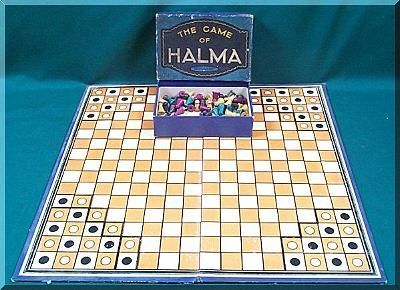Halma (1884) Board Game
Halma is an abstract strategy board game that was invented in 1884 by George Howard Monks. The game’s name is derived from the Greek word for “jump,” and it has since become a classic in the world of board gaming. Halma is played on a square grid board with a checkered pattern, and the objective of the game is to be the first player to move all of your pieces from your starting corner to the corner directly opposite.
Game Components of Halma
How To Setup Halma
Halma is set up on a 16×16 square board with each player’s camp in one of the corners. For a two-player game, each player starts with 19 pieces in opposite corners. In a four-player game, each player starts with 13 pieces, one in each corner. The game begins after players decide who moves first, often determined randomly.
Gameplay Mechanics and Game Objective
Player Experience
Playing Halma requires a mix of strategy and tactical thinking. The game has three distinct phases: the initial setup, the middle game where pieces interact and jump over each other, and the endgame where players rush to move their remaining pieces into the opposing camp. Players need to be patient and attentive to identify and capitalize on jumping opportunities, making the game both challenging and rewarding.
Pros
Cons
Personal Thoughts on Halma
Halma is an excellent game for anyone who enjoys strategic board games with a simple yet deep gameplay mechanic. It is particularly suitable for families and casual gamers who want to engage in a game that is both fun and intellectually stimulating. For those who enjoy games like checkers or chess but are looking for something different, Halma offers a unique and challenging experience. Overall, it is a timeless classic that continues to entertain and challenge players of all ages.
We are supported by our audience. When you purchase through links on our site, we may earn an affiliate commission, at no extra cost for you. Learn more.

